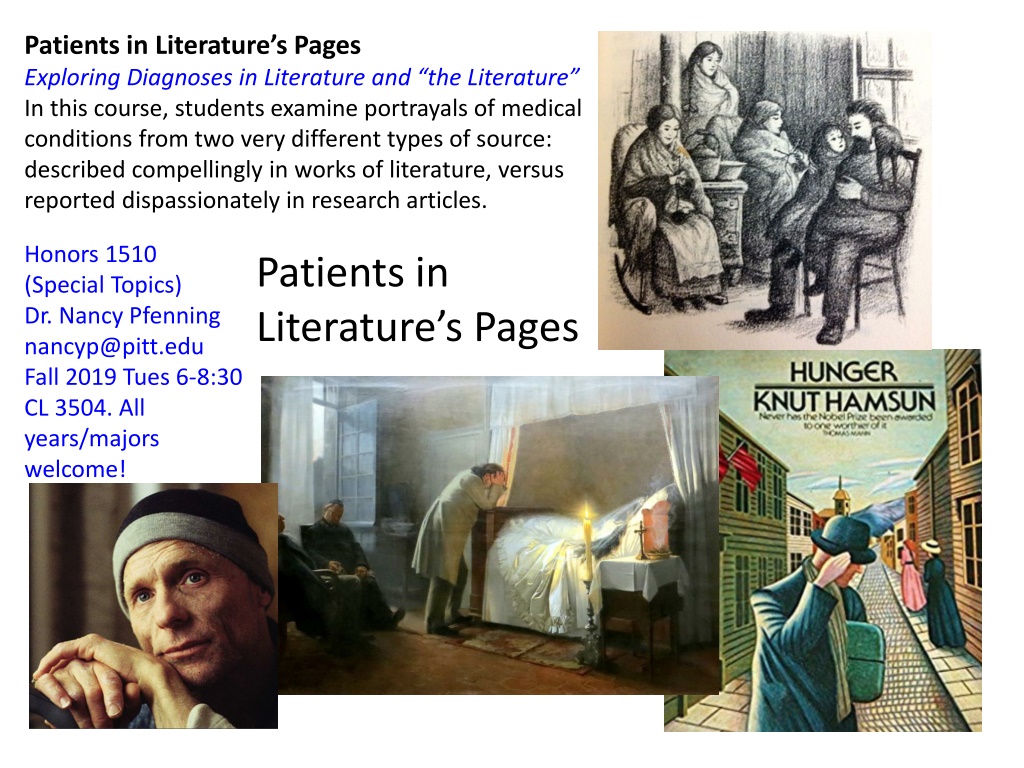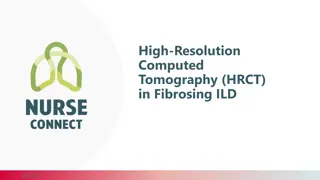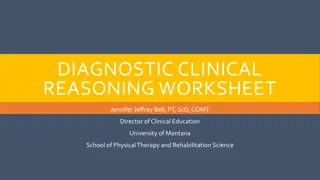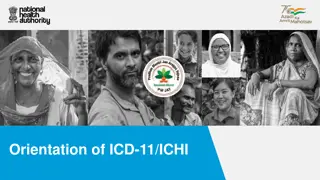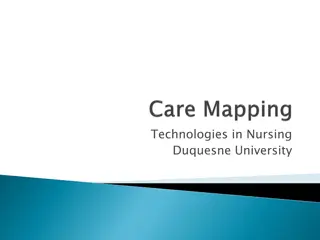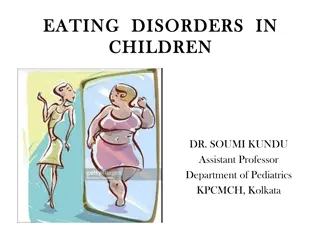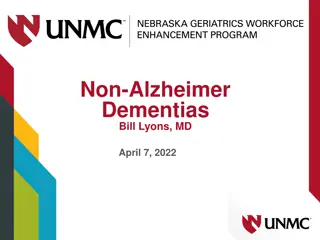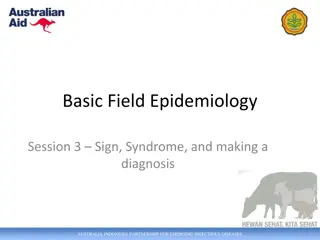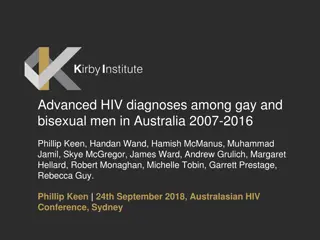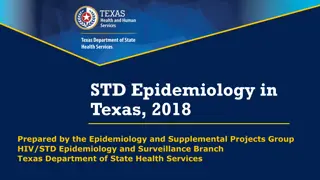Exploring Diagnoses in Literature and the Literature
This course delves into portrayals of medical conditions in literature versus research articles. It explores the intersection of science and literature, analyzing works like "Black Swan Green" and "The Reason I Jump" to understand how they depict conditions like stuttering and autism. Through student presentations and research, the course aims to foster empathy and deeper understanding of these conditions within a literary context.
Download Presentation

Please find below an Image/Link to download the presentation.
The content on the website is provided AS IS for your information and personal use only. It may not be sold, licensed, or shared on other websites without obtaining consent from the author. Download presentation by click this link. If you encounter any issues during the download, it is possible that the publisher has removed the file from their server.
E N D
Presentation Transcript
Patients in Literatures Pages Exploring Diagnoses in Literature and the Literature In this course, students examine portrayals of medical conditions from two very different types of source: described compellingly in works of literature, versus reported dispassionately in research articles. Honors 1510 (Special Topics) Dr. Nancy Pfenning nancyp@pitt.edu Fall 2019 Tues 6-8:30 CL 3504. All years/majors welcome! Patients in Literature s Pages
Outline Origin of idea for course UHC mission, Course s learning goals Format Intended medical conditions/literary works Laying groundwork for course s success First lecture: broader discussion about relevant quotes Assessment of students and of the course
Origins of Idea for Course F15: I taught Honors Stat 1000, with weekly presentations by students on stats applications in journal articles. F15: UHC offered tickets for author David Mitchell s talk at Carnegie Music Hall, to classes for which it would be relevant. Motivation to tie together ideas from science and literature
Special Presentation #1: Stuttering and Black Swan Green Semi-autobiographical novel by Mitchell (a stutterer) includes a chapter about the effects of this affliction on the young protagonist. Jessica C. scrutinized Psychological Health and Coping Strategies of Adolescents with Chronic Stuttering (Journal of Child & Adolescent Behavior). She associated behaviors described in the novel with coping strategies mentioned in the article, such as escape, worry, resignation, aggression. There were some statistical analyses involved.
Follow-up to Special Presentation #1: Stuttering and Black Swan Green Course UTA Stacy M. was inspired to write a paper about the novel for her CSD class. Stacy cited multiple recent journal articles about stuttering, examining the novel s effectiveness in portraying typical characteristics of stuttering, and the merits of boy s tactics to avoid detection and persecution. She also assessed efficacy of his speech therapy, based on current research. By intertwining these truths about stuttering with a quirky yet endearing protagonist, Mitchell effectively invokes empathy from nonstutterers and provides encouragement for fellow stutterers.
Special Presentation: Autism and The Reason I Jump David Mitchell translated this work by 13-year- old Naoki Higashida, who is autistic. Eva G. scrutinized 14 behaviors in the Childhood Autism Rating Scale (CARS), a widely used diagnostic tool. She had class members match each one with a section of Higashida s book that explicated such behavior from his own perspective.
Autism and The Reason I Jump VII. Abnormal listening response may be startled or cover ears when hearing some everyday sounds. Q27. Why do people with autism often cup their ears? There are certain noises you don t notice but that really get to us. It s not quite that the noises grate on our nerves. It s more to do with a fear that if we keep listening, we ll lose all sense of where we are. So cupping our ears is a measure we take to protect ourselves and get back our grip on where we are.
Autism and The Reason I Jump (ctd) XIII. Abnormal activity level The child may be quite active and difficult to restrain. He or she may have boundless energy Q25. What s the reason you jump? What do you think I m feeling when I m jumping up and down clapping my hands? I bet you think I m not really feeling anything much beyond the manic glee all over my face. But when I m jumping, it s as if my feelings are going upward to the sky When I m jumping, I can feel my body parts really well, too---my bounding legs and my clapping hands---and that makes me feel so, so good.
Most Successful Lesson (IMHO) in a Highly Successful Course
From Dream Course to Reality May 9: decided to retire as of end of Sept. May 18: met with UHC Dean Primack to discuss possibility of teaching course in the future Sept: applied for and received dB-SERC grant to develop and teach course Second Opinion: Diagnoses in Literature and The Literature Oct: Patients in Literature s Pages approved as 3-credit F19 UHC Special Topics Course
Pitts Honors College: Mission The mission of the University Honors College (UHC) is to meet the academic and extracurricular needs of the University of Pittsburgh's most able, ambitious, and inquisitive undergraduate students by providing intellectual challenges, inspiring individual effort, encouraging independent thinking and self-discovery, and fostering a nurturing community.
Courses Learning Goals Guide students to Value the information gleaned from both sources: literary works, scientific reports Read such works with discernment Process the ideas separately and then in combination: how do the lessons learned in each of the two support one another? Are there inconsistencies? Give a coherent presentation on what has been learned about the medical condition via those two types of work Lead a discussion about the above Write about what we glean from writings that are objective/subjective; also from the two in tandem
Additional Learning Goals Guide students to feel more relaxed about reading medical journal articles/literary works in depth feel more relaxed about discussing medical journal articles/literary works in depth. have increased confidence in being able to present ideas from medical journal articles/literary works. Stimulate students enthusiasm for medical journal articles/literary works.
Format Each week one (or two?) of the 12 students will present on a condition described in a work of literature plus at least one accompanying scientific report, comparing and contrasting relevant details. All members of the class will have read and commented on these works before the presentation. Afterwards, presenter will lead a discussion of what they have discovered from the readings, individually as well as synergistically.
A Semesters Worth of Patients from Literature s Pages: Fall 2019 Acute myeloid leukemia during pregnancy: In Every Moment We Are Still Alive by Tom Malmquist AIDS: The Hours by Michael Cunningham Alzheimer's: Still Alice by Lisa Genova, The Father by Florian Zeller Arsenic poisoning: Madame Bovary by Gustave Flaubert Autism: The Reason I Jump by Naoki Higashida Clerambault's Syndrome: Enduring Love by Ian McEwan Drug/Alcohol Addiction: Infinite Jest by David Foster Wallace
A Semesters Worth of Patients from Literature s Pages: Fall 2019 PTSD: The Names of the Dead by Stewart O'Nan Rape survival: A Woman in Berlin by Anonymous OCD: A Plague of Tics; Smoking Cessation: When You Are Engulfed In Flames, both by David Sedaris Starvation: Hunger by Knut Hamsen; The Long Winter by Laura Ingalls Wilder; One Day in the Life of Ivan Denisovich by Aleksandr Solzhenitsyn? Stuttering: Black Swan Green by David Mitchell Suicide: A Long Way Down by Nick Hornby Tuberculosis: The Magic Mountain by Thomas Mann Cancer: Cancer Ward by Aleksandr Solzhenitsyn?
Input from other Faculty Discussed informally with colleagues at UHC First Fridays for Faculty Fellows & Friends (F6) meeting in October Presenting on course at Dec. F6 meeting Suggestions/comments from dB-SERC colleagues?
Promotion Strategies UHC colleagues (Aziz, Dechant, Chong) helpful Shea Higgins (UHC new Marketing and Communications Specialist) now actively promotes new courses Will contact Pitt Interprofessional Center for Health Careers advisor Andrea Abt in spring
Planning 1st Lecture of Semester Broader discussion of relative merits of two forms of communication: objective scientific articles, subjective literary works 12 students break into smaller groups and discuss various relevant quotations, then summarize key ideas to report to entire class
Ruth Stalker-Firth (Computer Science PhD from EPFL and blogger) 2016: narrative creates order and the database does not. The database represents the world as an unordered list of items which causes the linear structure of a narrative beginning-middle-end to disappear leaving us with the possibility of multiple interpretations and multiple stories. John Lubbock (Communications Coordinator, Wikimedia UK) 2018: The brain has dual systems for experiencing reality and for remembering and constructing a narrative out of those experiences. American writer Mark Twain: It s no wonder truth is stranger than fiction. Fiction has to make sense. Doris Lessing (literature Nobel Prize winner): There is no doubt fiction makes a better job of the truth. from Under My Skin, 1994
Raymond Wolfinger (political scientist) 1969: The plural of anecdote is data. D. Kahneman and A. Tversky: These Nobel prize winners presented subjects with the following statement: Linda is 31 years old, single, outspoken, and very bright. She majored in philosophy. As a student, she was deeply concerned with issues of discrimination and social justice, and also participated in antinuclear demonstrations. They then asked subjects to choose which of these two statements was more probable: 1. Linda is a bank teller. 2. Linda is a bank teller who is active in the feminist movement.
Kahneman and Tversky report that in a large sample of statistically na ve undergraduates, 86% judged the second statement to be more probable. Their heuristic was faulty because those in the second statement are a subset of those in the first, which makes the occurrence less probable. But students chose the second because the added detail, which includes a more personal touch, makes it more representative of their mental impression of Linda.
Assessing Students 50% for presentations 15% for attendance/participation 15% for written questions/comments 20% for final paper
Assessing Course: Pre/Post Survey 1/2. In general, I find literature/medical research interesting.
Assessing Course: Pre/Post Survey 1/2. In general, I find medical research/literature interesting. 3/4. I want to learn as much as possible about medical research/literature. 5/6. Other people in the class know more than I do about medical research/literature. 7/8. I feel apprehensive at the prospect of trying to read a medical journal article/serious literary work. 9/10. If I want, I can successfully read and understand a medical journal article/serious literary work. 11/12. In-depth reading of medical journal articles/literary works will help me in courses in my major. 13/14. In-depth reading of medical journal articles/literary works will help me to ultimately get into a grad program and/or get a job that I want. 15/16. I feel I might not belong in this class because I lack the background in reading scientific articles/literary works in depth.
Assessing Course: Post Survey* 17/18. My interactions with other students in this class made me feel more relaxed about reading medical journal articles/literary works in depth. 19/20. My interactions with other students in this class made me feel more relaxed about discussing medical journal articles/literary works in depth. 21/22.My interactions with other students in this class increased my confidence in being able to present ideas from medical journal articles/literary works. 23/24. My interactions with other students in this class stimulated my enthusiasm for medical journal articles/literary works. 25.Please report your major(s) or indicate if you are still undecided: __ 26. ? I learned to make connections between science and literature. Would you like to make any other comments regarding how you feel about the course? *Thanks to Chandralekha for supplying Physics survey as model.
Acknowledgement Thanks to dB-SERC, who provided a grant to fund me in creating and teaching this course. Questions, comments, suggestions are welcome: nancyp@pitt.edu
Acute myeloid leukemia during pregnancy: In Every Moment We Are Still Alive by Tom Malmquist AIDS: The Hours by Michael Cunningham Alzheimer's: Still Alice by Lisa Genova, The Father by Florian Zeller Arsenic poisoning: Madame Bovary by Gustave Flaubert Autism: The Reason I Jump by Naoki Higashida Clerambault's Syndrome: Enduring Love by Ian McEwan Drug/Alcohol Addiction: Infinite Jest by David Foster Wallace PTSD: The Names of the Dead by Stewart O'Nan Rape survival: A Woman in Berlin by Anonymous OCD: A Plague of Tics; Smoking Cessation: When You Are Engulfed In Flames, both by David Sedaris Starvation: Hunger by Knut Hamsen; The Long Winter by Laura Ingalls Wilder; One Day in the Life of Ivan Denisovich by Solzhenitsyn Stuttering: Black Swan Green by David Mitchell Suicide: A Long Way Down by Nick Hornby Tuberculosis: The Magic Mountain by Thomas Mann The Winter Soldier by Daniel Mason? A Test of Wills by C. Todd?
